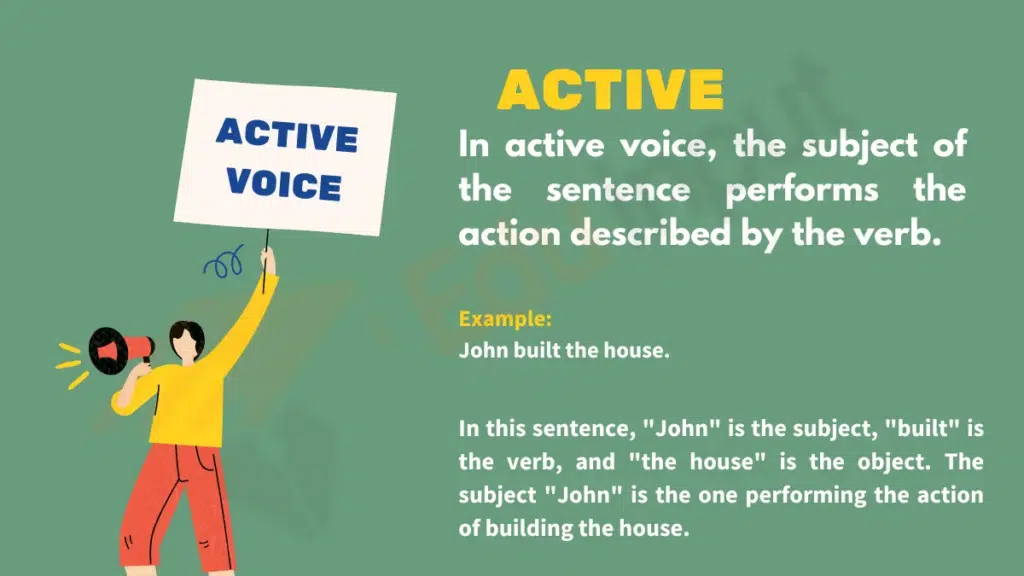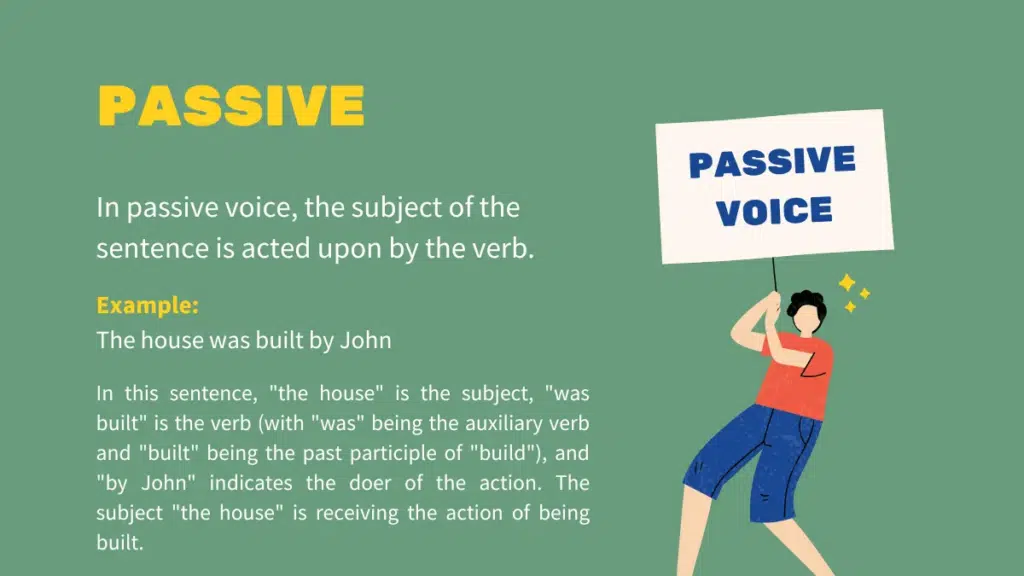Active and Passive Voice – Difference, & Examples
What is Voice?
The ‘voice’ is a term that is used to show how a word changes when we talk about who is doing something or who is receiving the action in a sentence.
The way a verb sounds tells us about how the action connects to the people or things (subjects or objects) in a sentence.
Two Voices in English Language
In English, there are two voices used in sentences.
1: Active Voice
2: Passive Voice
Active Voice

In a sentence with an active voice, the subject, which can be a noun or pronoun, is the one doing the action. Simply put, the subject acts or does something to the verb.
According to the Oxford Learner’s Dictionary, the active voice is when the subject of a sentence is the one performing the action. Similarly, as per the Collins Dictionary, the active voice in verbs indicates that the subject is carrying out the action or causing the event or process described by the verb.
- In active voice, the subject performs the action.
- Example: “The dog chased the ball.” (The subject, “the dog,” is doing the action of chasing.)
Passive Voice

On the other side the passive voice indicates that the subject is the one being affected by the action or verb in the sentence. The passive voice suggests that the subject in the sentence is no longer in an active role but has become passive.
As per the Oxford Learner’s Dictionary, the passive voice is employed when the subject is influenced by the action of the verb. Likewise, according to the Collins Dictionary, the passive voice is constructed by using ‘be’ and the past participle of a verb. In a passive clause, the subject does not carry out the action expressed by the verb but is instead impacted by it.
- In passive voice, the subject receives the action.
- Example: “The ball was chased by the dog.” (Here, the subject, “the ball,” is receiving the action of being chased.)
Using the Active Voice and the Passive Voice – Points to Remember
When employing the active voice and the passive voice, it’s important to consider a few points. In English, the active voice is generally preferred as it conveys information directly and clearly.
Avoid using the passive voice solely for perceived aesthetic reasons; opt for it only when necessary.
Keep in mind that the active voice involves the subject performing the action, while the passive voice has the subject receiving the action.
To ensure clear and effective communication, especially in professional contexts, prioritize the use of the active voice.
A helpful tip for mastering both voices is to understand their structures and formulas.
Active Voice – Subject + Verb + Object
Passive Voice – Object + Verb + Subject
Difference between the Active Voice and the Passive Voice
| Aspect | Active Voice | Passive Voice |
| Denotation | The subject is performing the action. | The subject is acted upon by the verb or action. |
| Linking Verb | The active voice does not require a linking verb to make sense. | Requires a linking verb followed by the past participle. |
| Focus | Emphasize the doer of the action | Useful when the doer of the action is undetermined. |
| Tone | Direct, clear, and strong | Indirect, weak, and subtle. |
| Examples | I decorated the hall. | The hall was decorated by me. |
| Ali gave Ahmed a gift. | 2. Ahmed was given a gift by Ali. |
| Change of Pronouns | |
| Active Voice | Passive Voice |
| She | Her |
| I | Me |
| He | Him |
| They | Them |
| We | Us |
| It | It |
Examples of Active Voice and Passive Voice
- Active Voice – The chef is preparing a delicious meal.
- Passive Voice – A delicious meal is being prepared by the chef.
- Active Voice – The team completed the project ahead of schedule.
- Passive Voice – The project was completed ahead of schedule by the team.
- Active Voice – Julia teaches Spanish to high school students.
- Passive Voice – Spanish is taught to high school students by Julia.
- Active Voice – The Company awarded John the Employee of the Month.
- Passive Voice – John was awarded the Employee of the Month by the company.
- Active Voice – The storm damaged the old bridge.
- Passive Voice – The old bridge was damaged by the storm.
- Active Voice – We have reserved tickets for the concert.
- Passive Voice – Tickets for the concert have been reserved by us.
- Active Voice – The teacher is explaining the new lesson.
- Passive Voice – The new lesson is being explained by the teacher.
- Active Voice – The gardener planted colorful flowers in the garden.
- Passive Voice – Colorful flowers were planted in the garden by the gardener.
- Active Voice – The committee will announce the results tomorrow.
- Passive Voice – The results will be announced by the committee tomorrow.
- Active Voice – They are building a new shopping mall downtown.
- Passive Voice – A new shopping mall is being built downtown by them.



Leave a Reply